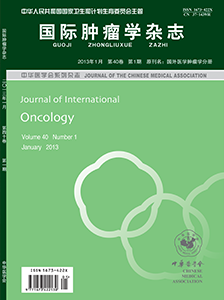Predictive value of serum low density lipoprotein for first-line treatment in extensive-stage small cell lung cancer
引用次数: 0
Abstract
Objective To investigate the relationship between serum low density lipoprotein (LDL) and the progression-free survival (PFS) of small cell lung cancer (SCLC) patients. Methods A total of 271 SCLC patients admitted to Shandong Cancer Hospital from May 1, 2014 to October 31, 2018 were selected. These patients were divided into limited-stage group (n=126) and extensive-stage group (n=145) according to Veteran′s Administration Lung Cancer Study Group (VALSG) evaluation standard. The correlation between the level of serum LDL before treatment and PFS was analyzed by Spearmen test in the two groups. After finding the cutoff value of LDL level by receiver operating characteristic curve (ROC) analysis, the relationship between LDL level before treatment and PFS was analyzed. According to the dynamic change of serum LDL during the treatment, extensive-stage patients were divided into four groups: normalized LDL group (n=25, patients whose LDL≤2.55 mmol/L and never increased until progression), increased LDL group (n=31, patients whose LDL≤2.55 mmol/L and increased at least once until progression), never-normalized LDL group (n=33, patients whose LDL>2.55 mmol/L and never normalized until progression), and decreased LDL group (n=56, patients whose LDL>2.55 mmol/L and decreased at least once until progression). Then the PFS among the four groups was compared. The survival curves were plotted by the Kaplan-Meier method and compared using the log-rank test. The significance of the independent variables for PFS in extensive-stage patients was analyzed using the Cox proportional hazards model. Results The median PFS for the whole cohorts was 7.1 months (1.4-27.1 months). The median PFS for limited-stage patients and extensive-stage ones was 8.8 months and 6.1 months respectively, with a significant statistical difference (χ2=28.723, P 2.55 mmol/L, n=164) for whole cohorts (9.0 months vs. 6.2 months, χ2=16.064, P 2.55 mmol/L before treatment (HR=0.436, 95%CI: 0.297-0.640, P 2.55 mmol/L and never normalized until progression (HR=2.215, 95%CI: 1.403-3.497, P 2.55 mmol/L before treatment (HR=0.435, 95%CI: 0.300-0.632, P 2.55 mmol/L and never normalized until progression (HR=2.028, 95% CI: 1.386-2.966, P<0.001) were independent risk factors for PFS, LDL normal during treatment (HR=0.318, 95%CI: 0.186-0.542, P<0.001) was independent protective factors of PFS. Conclusion The serum LDL level may be used as a potential predictive marker for PFS in extensive-stage SCLC patients subjected to the first-line chemotherapy. Key words: Lipoproteins, LDL; Small cell lung carcinoma; Treatment outcome; Forecasting; Progression-free survival血清低密度脂蛋白对广泛期小细胞肺癌一线治疗的预测价值
目的探讨血清低密度脂蛋白(LDL)与小细胞肺癌(SCLC)患者无进展生存期(PFS)的关系。方法选取2014年5月1日至2018年10月31日山东省肿瘤医院收治的271例SCLC患者。根据美国退伍军人管理局肺癌研究组(VALSG)评估标准,将患者分为有限期组(n=126)和广泛期组(n=145)。采用spearman试验分析两组患者治疗前血清LDL水平与PFS的相关性。经受试者工作特征曲线(receiver operating characteristic curve, ROC)分析,找到LDL水平的临界值后,分析治疗前LDL水平与PFS的关系。根据治疗过程中血清LDL的动态变化,将广泛期患者分为四组:LDL归一化组(n=25, LDL≤2.55 mmol/L且未升高至进展)、LDL升高组(n=31, LDL≤2.55 mmol/L且至少升高1次至进展)、LDL未归一化组(n=33, LDL>2.55 mmol/L且未升高至进展)、LDL降低组(n=56, LDL>2.55 mmol/L且至少降低1次至进展)。比较四组患者的PFS。生存曲线采用Kaplan-Meier法绘制,采用log-rank检验进行比较。采用Cox比例风险模型分析大分期患者PFS的自变量的显著性。结果整个队列的中位PFS为7.1个月(1.4-27.1个月)。有限期和广泛期患者的中位PFS分别为8.8个月和6.1个月,两组患者治疗前(9.0个月vs 6.2个月,χ2=16.064, P 2.55 mmol/L) (HR=0.436, 95%CI: 0.297-0.640, P 2.55 mmol/L)和治疗前未恢复正常(HR=2.215, 95%CI: 1.403-3.497, P 2.55 mmol/L) (HR=0.435, 95%CI:0.300 ~ 0.632, P 2.55 mmol/L及进展前未正常化(HR=2.028, 95%CI: 1.386 ~ 2.966, P<0.001)为PFS的独立危险因素,治疗期间LDL正常(HR=0.318, 95%CI: 0.186 ~ 0.542, P<0.001)为PFS的独立保护因素。结论血清LDL水平可作为一线化疗大分期SCLC患者PFS的潜在预测指标。关键词:脂蛋白;LDL;小细胞肺癌;治疗效果;预测;无进展生存
本文章由计算机程序翻译,如有差异,请以英文原文为准。
求助全文
约1分钟内获得全文
求助全文

 求助内容:
求助内容: 应助结果提醒方式:
应助结果提醒方式:


